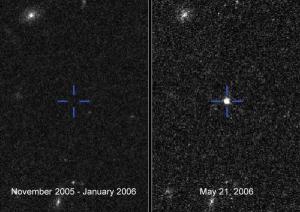Astronomers are still unable to explain a mysterious bright area discovered by NASA's Hubble Space Telescope in 2006. This may be a new type of star that has long since disappeared in the universe, the researcher said.
Astronomers often observe intense light originating from stellar explosions, such as supernovae or supernovae. The Hubble Telescope discovered the space of the universe on February 21, 2006, illuminating it for 100 days leaving the fading light for the next 100 days.
Brightness increases and decreases is a phenomenon never recorded in any event related to how.Supernova reached its peak after only a maximum of 70 days, gravity-related events were much shorter. Therefore, this observation does not follow the usual explanation, says Kyle Barbary of Lawrence Berkeley National Laboratory in Berkeley, Calif. He described this strange observation of the Hubble telescope at the 213th meeting of the American Astronomical Society in Long Beach, Calif. He concluded: 'We have never seen anything like that'.
 Two photographs of NASA's Hubble Space Telescope show the appearance of a bright area discovered on February 21, 2006, illuminating for more than 100 days, then fading away for the next 100 days. The origin of this halo is still unknown. (Photo: NASA, ESA, and K. Barbary (University of California, Berkeley / Lawrence Berkeley National Laboratory, Supernova project)
Two photographs of NASA's Hubble Space Telescope show the appearance of a bright area discovered on February 21, 2006, illuminating for more than 100 days, then fading away for the next 100 days. The origin of this halo is still unknown. (Photo: NASA, ESA, and K. Barbary (University of California, Berkeley / Lawrence Berkeley National Laboratory, Supernova project)
The spectral signature of the light from the object that is included in the SCP 06F6 list, has not been identified.Scientists surmise that it is a star's carbon-sucking line of 1 billion light-years away.
However, efforts to find the source of light in many astronomical surveys have yet to provide any evidence of a star or galaxy at the location of the light region.The cosmic supernova project at LBNL discovered this bright spot at random while searching for a supernova.
The Hubble Telescope is aimed at a cluster of galaxies 8 billion light-years away, weighing the Bootes constellation. But this mysterious object can be anywhere in the middle, including in the halo of the Milky Way
The articles published by other researchers after the event was reported in June 2006 showed some strange possibilities: the explosion of a carbon-rich star, colliding between a white star and an onion. fine, or collide between a white star with a black hole.
However, Barbay does not think that these hypotheses can fully explain this phenomenon: 'I do not mean that we can explain this discovery until we observe similar objects in the future. hybrid '.
All-sky surveys, such as surveys conducted with the General Survey Telescope, can detect similar events in the universe.
 Van Allen's belt and evidence that the Apollo 11 mission to the Moon was myth
Van Allen's belt and evidence that the Apollo 11 mission to the Moon was myth The levels of civilization in the universe (Kardashev scale)
The levels of civilization in the universe (Kardashev scale) Today Mars, the sun and the Earth are aligned
Today Mars, the sun and the Earth are aligned The Amazon owner announced a secret plan to build a space base for thousands of people
The Amazon owner announced a secret plan to build a space base for thousands of people